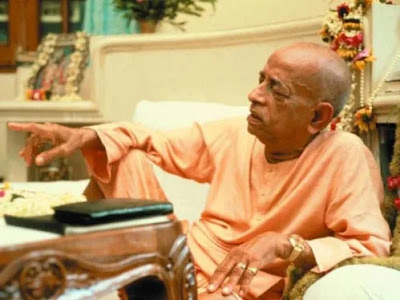Buddhism is an act of camouflage by the Lord, Part 2
.jfif)
„ Lord Buddha is accepted as incarnation in the Śrīmad-Bhāgavatam. And during the time of Emperor Aśoka, he was patronized, Lord Buddha was patronized, not Buddha, or Buddhism was patronized by Aśoka. So practically the whole of Far East, including India, all over, the Buddhism was broadcast and everyone become Buddhist. Whole of India, practically, became Buddhist during his time. But later on, after Śaṅkarācārya's drive against Buddhism, Buddha-ism... Śaṅkarācārya wanted to establish the difference of Buddhism and Hinduism is that Buddhism, Lord Buddha did not accept Vedic authority. He did not accept Vedic authority.” (Lecture on CC Madhya-lila 20.353-354 -- New York, December 26, 1966)
„Then Śaṅkarācārya came and he preached this almost Buddhism. The Buddha, Lord Buddha preached that there is no God, there is no soul. This body is combination of matter and if we dissolve this material combination then there is no more perception of misery or happiness. That is nirvāṇa. That is his philosophy.” (Lecture on BG 4.7 -- Montreal, June 13, 1968)
„Śaṅkarācārya... Śaṅkarācārya, after Buddha, His Holiness Śaṅkarācārya appeared to drive away Buddhism, and he established again Vedic religion. But that Vedic religion, being impersonal, that is also not Vedic religion. That is also another thing, that God is person.” (Lecture on SB 6.1.40 -- Surat, December 22, 1970)
„Although Māyāvādī philosophers pretend to accept the Vedic principles, they indirectly preach Buddhist philosophy, or atheistic philosophy, and do not accept the Supreme Personality of Godhead. Māyāvādī philosophy is inferior to Buddhist philosophy, which directly denies Vedic authority. Because it is disguised as Vedānta philosophy, Māyāvādī philosophy is more dangerous than Buddhism or atheism.” (Teachings of Lord Caitanya, Chapter 25)
„Dr. Cenkner is correct in saying that Sankaracarya's belief is personal. Actually he is a covered personalist. He became impersonalist just to drive away Buddhism. All of India was Buddhist voidism. So, although a personalist, he had to keep pace with voidism by expounding impersonalism. There is very little difference between impersonalism and voidism, but because he had to bring Buddhists back to the Vedic cultural form, he adopted impersonalism. From the Padma Purāṇa, it is learned that Sankaracarya is Lord Siva, and who can be a greater devotee than Lord Siva? Lord Siva is considered to be the foremost Vaisnava.” (Letter to Damodara -- Bombay, India 12 November, 1970)
„Although Buddhism, we do not accept the
philosophy of Buddhism, we Vaiṣṇava, we do not accept, but we accept Lord
Buddha as incarnation of Kṛṣṇa. Keśava dhṛta-buddha-śarīra, jaya jagadīśa hare.
Sadaya-hṛdaya darśita-paśu-ghātam. Lord Buddha appeared, being very much
compassionate on the matter of animal slaughter.”
(Pandal
Lecture -- Bombay, January 14, 1973)



Comments
Post a Comment